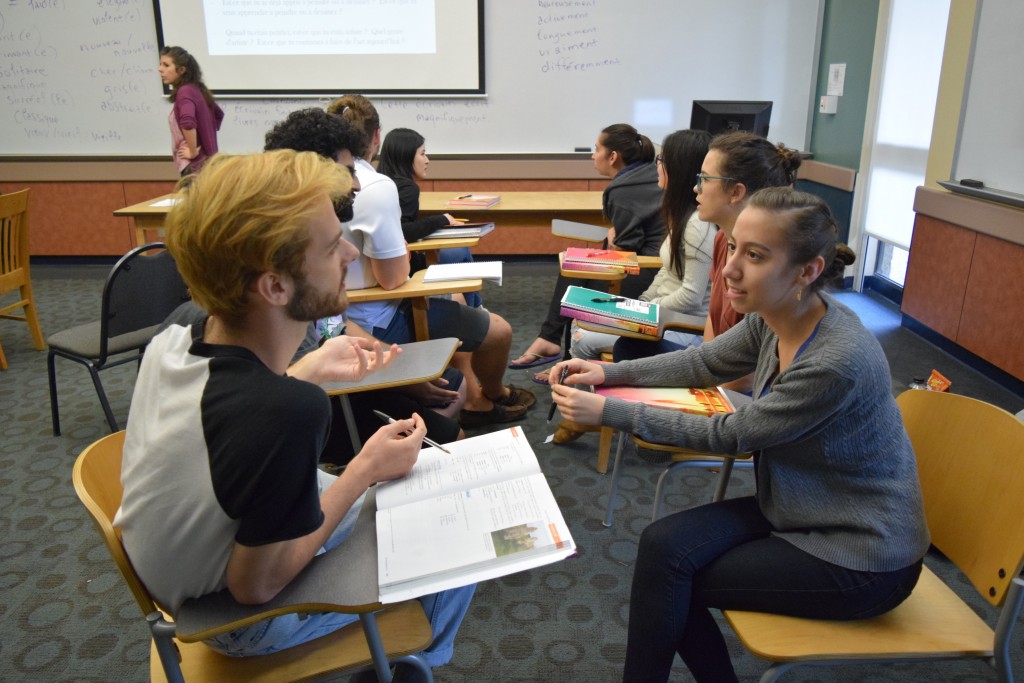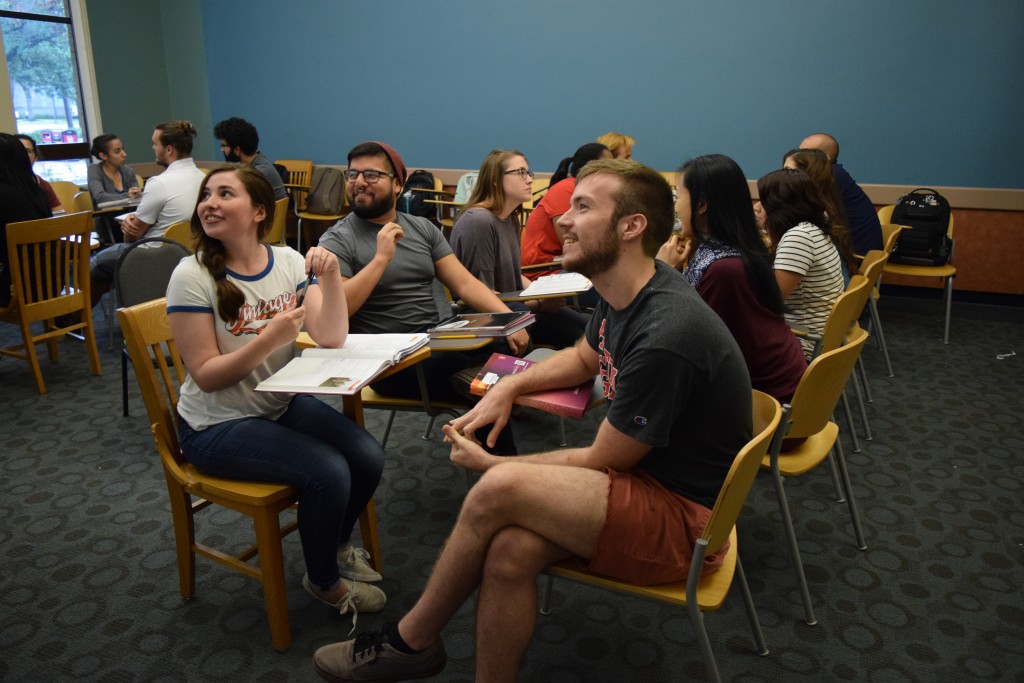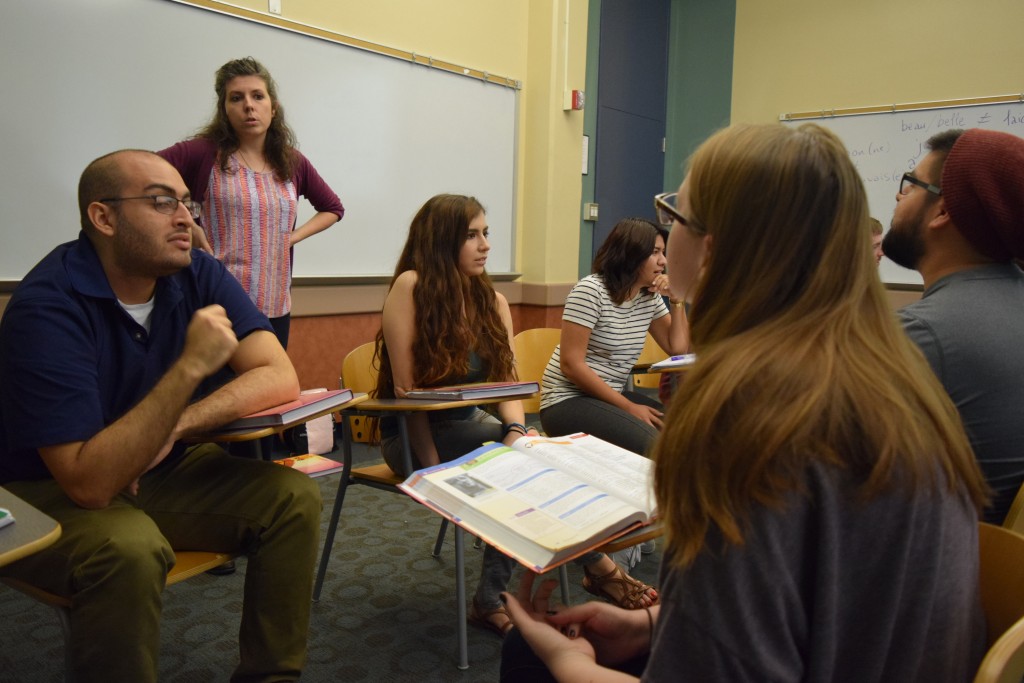This is the third installment of a monthly series showcasing innovative teaching practices in the Department of Hispanic Studies and the Department of Modern and Classical Languages.
Dr. Rachel Early, lecturer in French in the Department of Modern & Classical Languages, is in this month’s Language Teaching Spotlight with a “speed dating” lesson plan intended to get students conversing in their target language. She was inspired by a graduate school classmate who introduced her to this activity, and has shared it in turn with her colleagues at UH such as Marie-Céline Johnson, a French lecturer who also uses it in her classes. While the students pictured in this post are currently taking second semester French (FREN 1502), Dr. Early has used this activity in various levels, from first semester (FREN 1501) to fourth (FREN 2302).
About the Activity
Students line up two rows of desks, paired up so each student seated at a desk is sitting across from a partner. Dr. Early projects 5-6 questions in French on the screen and asks students to repeat the questions after her in order to practice pronunciation. Next, a timer is set (optional) and students pose questions from the list to their partner; the duration will depend on the length and complexity of the questions (typically 1-3 minutes). When time is up, students in one row of desks stand up and move one desk to their right. This way, learners gain experience hearing the same questions repeatedly, from different conversation partners, as well as experience responding multiple times and becoming comfortable with that language function. Additionally, students are able to practice in a low-stakes environment: they are focused on interacting with their partner rather than preoccupied about their performance in front of the class and teacher.
Comment vas-tu? (Je vais bien / mal, et toi? / etc.)
[How are you? (I’m good / bad, and you? / etc.)
Combien de cours suis-tu ce semestre? Combien de cours est-ce que tu as-suivis le semestre dernier?
A la fin de tes études, à l’université de Houston, où est-ce que tu veux vivre? Pourquoi? Tu espères faire quoi, après l’université?
Est-ce que tu a déjà écrit de poèmes? Des chansons? Un roman?
Est-ce que tu as déjà appris à peindre ou à dessiner? Est-ce que tu veux apprendre à peindre ou à dessiner?
Quand tu étais petit(e), est-ce que tu étais artiste? Quel genre d’artiste? Est-ce que tu continues à faire de l’art aujourd’hui?
How many classes are you taking this semester? How many classes did you take last semester?
When you finish your studies at UH, where do you want to live? Why? What do you hope to do after college?
Have you ever written poetry? Songs? A novel?
Have you ever learned to paint or draw? Do you want to learn to paint or draw?
When you were little, were you an artist? What kind of artist? Do you continue to make art today?]
While a more traditional pair work activity would require students to either work with only one partner, or to walk around the room finding successive partners (to fill out a table of other students’ responses to questions, for example), Dr. Early finds that the speed dating model works well because each learner is guaranteed a partner for the duration of the activity, and time is not lost on finding a new partner given the activity’s fast-paced nature.
Variations
Dr. Early suggests the following variations on this activity:
- Have students take notes on each partner’s responses, then come up with follow-up questions to ask in a second “speed dating” round
- Ask students to create a list of their own questions to ask their partners
- Incorporate a pre-speaking task where students have time to first answer the questions in writing
Learning Outcomes
The speed dating activity is a non-threatening and playful way to promote communication and language use in the classroom, as it gives students significant “time on task” to try out new expressions, words, and structures, and to get experience with spontaneous, relaxed conversation. Dr. Early has observed that students have fun doing this activity and gain awareness of the holes in their ability to express themselves, which they then address by asking the instructor for help. Since students in first- and second-year French classes are new to the language, they are often intimidated when it comes to speaking in the target language. By gaining confidence in their language ability in a low-stress situation, learners are empowered to use their French to communicate.



